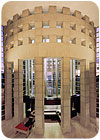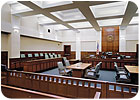
Modern courthouses provide a public presence that expresses stability, integrity, and fairness of the court, while maintaining an open and inviting atmosphere. These facilities must contribute positively to the architectural fabric of the local community, and as with any building, life safety and health concerns, aesthetics, automation, interior finishes, and barrier-free access are of major importance. Because of the specialized functions and requirements of the courthouse, additional emphasis must be placed on security and acoustics.
The highly stressful work and the constantly varying occupancy typical of courthouses demands the best possible indoor environment. This requires effective and efficient lighting, modern life safety systems, and precise temperature, humidity, and ventilation control. While it is seldom seen, the HVAC system plays a major role in meeting the unique technical requirements of every new courthouse. The high level of finish found in woodwork, art objects, and other critical decorative features requires that both temperature and humidity be accurately controlled for proper preservation.
Because of the high level of occupancy, IAQ is of the utmost importance. This means that a sufficient amount of clean outside air must be supplied to each space at the right temperature and humidity.
As we face the increasing concerns of security in today's world, courthouses must fully adhere to the latest security design guidelines and all aspects of antiterrorism protection, including those relating to bioterrorism.

Effective HVAC Zoning
While the public areas normally operate within the traditional 9-to-5 schedule, the courtrooms and the judicial staff areas frequently experience irregular occupancy. Judges and court staff regularly work long hours during nights and weekends, while courtrooms may remain vacant for days at a time. To achieve efficient operation, the HVAC systems must be zoned to respond to these irregular schedules.Public areas, courtrooms, and judicial staff areas should each be served by separate AHUs. This will maintain a comfortable environment in occupied areas of the building while reducing overall heating, cooling, and ventilation in unoccupied spaces. Proper AHU zoning can also control and minimize the effects of air contamination, either accidental or as a result of an act of terrorism. By separating the courtrooms and court staff spaces from the public areas, the contamination hazard to the judicial staff can be minimized. If the courthouse contains holding cells, these should also have a separate AHU zone to facilitate smoke evacuation and to minimize disruptions to other areas in case of fire or other disturbing event.
Many courthouses have atriums to contribute to their monumental stature. Because the requirements of these spaces differ from the rest of the building, they should have a separate AHU to properly control temperature and pressurization and to simplify smoke control in event of fire.
Requirements now in effect for anti-terrorism mandate that outside air intakes be located well above ground level to minimize the possibility of introduction of hazardous or objectionable substances. Placing air intakes at or close to roof level will normally meet this requirement and will ensure the freshest possible ventilation air for the building. Limiting the size of AHUs will help to minimize the effect of shutdowns during maintenance or mechanical failure.
System Types
In courthouse design, VAV systems are often the preferred choice. As part of the VAV concept, supply air to each space is varied in response to individual heating or cooling requirements. However, in order to maintain good temperature control and proper ventilation, supply airflow into the space should stay at or above a fixed minimum of 30% to 50%. Consequently, hot water reheat coils are used to heat the air and avoid overcooling. In order to minimize energy usage, waste heat recovered from the chillers often accomplishes this reheat.Where climatic conditions indicate it is feasible, AHUs should use the so-called "airside economizer." This concept utilizes 100% outside air to cool the building whenever the outdoor temperature is suitable and thus reduces utility costs by minimizing or actually eliminating the use of mechanical cooling during much of the year. In addition, due to the 100% outside air used, the concept provides the best possible IAQ and allows effective smoke evacuation in case of fire.

Acoustical Considerations
The court process demands an acoustical environment rivaled only by a concert hall. To achieve this, the courtroom HVAC system must be essentially inaudible so that all testimony can be clearly heard and understood by those present. The total privacy essential in judges' chambers and conference rooms can only be guaranteed if sound is not permitted to transfer between spaces through ductwork. While fiberglass lining has long been used to reduce this transmission, concerns over IAQ in recent years have limited its use to return and exhaust ducts only. In supply ducts, sound attenuators may be used to minimize transmitted noise, and acoustical blankets may be applied to the outside of ducts to reduce breakout noise.A fully occupied courtroom can require a large quantity of air for cooling and ventilation. Multiple smaller air terminal units (ATUs) can reduce noise generated from this source. Duct attenuators installed at the outlet of each ATU provide further sound reduction. Select and size individual diffusers to minimize generated sound; they should be located carefully to avoid drafts. Supply diffusers and return grilles should not have integral balancing dampers. All balancing should be done by dampers located in the ducts as far upstream as practical to minimize noise reaching the space and should be easily accessible for adjustment.
Well-designed ductwork is important to any project but is especially critical where acoustics are a major factor. Turbulence and high-pressure loss will inevitably generate noise and can only be avoided by adequate duct size, fittings, and transitions. Because of their increased rigidity, round or flat oval ducts generally provide superior acoustical isolation. Constructing ducts of heavier gauge sheet metal than usual also can reduce breakout noise.
In order to provide many years of useful life, and to prevent noise and vibration to occupied areas, specify larger AHUs as industrial grade. They should have internally isolated fans and 4-in. double-wall insulated construction. In addition, silencers should be included at the supply fan discharge and return fan intake. ATUs are best located in corridors where noise transmission into the room is minimized, and maintenance is less disruptive. For critical applications, provide sound attenuators downstream of the ATU to further reduce the impact of the HVAC system on the space.
The fans, pumps, and other machinery used for building A/C can create obtrusive vibration that, if not properly controlled, can be transmitted throughout the building structure. If possible, locate this equipment remotely from courtrooms and private offices, separated by "buffer" rooms. Where equipment must be located directly above sensitive areas, a floating floor separated from the structure by vibration isolators can reduce transmitted vibration and noise. Design all freestanding fans and pumps with flexible connections, mounting them on inertia bases with spring isolators. Ducts and large pipes in and near mechanical rooms should be supported on spring type hangers.

ENERGY EFFICIENCY
Courthouses are large energy users. They frequently have large windows, high floor-to-floor heights, unusually elaborate lighting systems, and heavy outdoor ventilation air requirements. Additionally, technological development has brought large numbers of computers, printers, and other electronic heat-producing equipment. All of these increase the cooling requirements and result in high HVAC energy consumption. Consequently, the potential to realize significant operating cost savings awaits through using high-performance HVAC equipment, improving the HVAC system efficiency, and enhancing energy management and control with a state-of-the-art BAS.In most buildings, but especially in courthouses, the largest HVAC energy users are fans. They are generally selected to deliver the volume of air required at peak cooling and ventilation conditions. Since this peak is required for only a small portion of the entire operating cycle, it should be reduced whenever possible to conserve energy. This is one of the justifications of the VAV concept.
Among methods available to decrease fan airflow, the AFD is the most efficient. It reduces the volume of air transferred by reducing motor speed, and results in significant energy savings. The concept of variable flow with the AFD can also be applied to circulating pumps used for chilled and condenser water, heating hot water, and domestic water distribution throughout the building.
Chiller heat recovery can be used effectively in conjunction with the reheat system. Instead of rejecting all chiller heat to a cooling tower, heat exchangers recover a portion that then provides space temperature control. The heat exchangers generate hot water which is used in terminal unit reheat coils, reducing or eliminating the coils' need for additional boiler-generated heat throughout much of the year.
